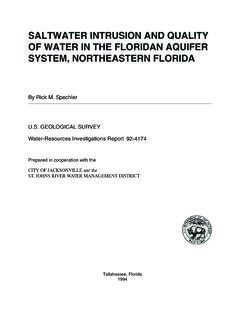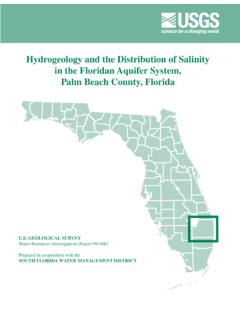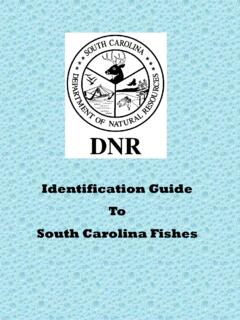Transcription of Stratigraphy and hydrogeology of a submarine collapse ...
1 61 The Engineering Geology and hydrogeology of Karst Terranes, Beck & Stephenson (eds) 1997 Balkema, Rotterdam. ISBN 90 5410 867 3 Stratigraphy and hydrogeology of a submarine collapse sinkhole on the continental shelf,northeastern FloridaRICK M. SPECHLER US Geological Survey, Altamonte Springs, Fla., USAWILLIAM Subsurface Evaluation, Inc., Winter Springs, Fla., USAABSTRACTRed snapper Sink is located on the continental shelf, about 42 km (26 ml) east of Crescent Beach, Florida. In1991, advanced technical-diving techniques enabled divers to explore the bottom of the sinkhole for the first opening of the sinkhole at a depth of m (90 ft) is approximately 122 m (400 ft) in diameter. The maximumrecorded depth in the sinkhole is 147 m (482 ft). The sloping sides of the sinkhole are developed on loose Holocenesand and shell from 27 to m (88 to 113 ft).
2 Pleistocene sand and clayey sand crop out from to 41 m (113 to134 ft). From 41 m (134 ft) to about 116 m (380 ft), Red snapper Sink is a vertical shaft measuring about m (150ft) in width to 52 m (170 ft) in length. The walls of the shaft from 41 to 50 m (134 to 164 ft) transect slightly induratedPliocene shelly sand. The walls are composed of moderately indurated Pliocene silty sands and sandy silts from 50 to63 m (164 to 206 ft). From 63 to 102 m (206 to 335 ft), the walls are developed in clayey sands and sandy clays of theUpper Hawthorn Group (Miocene). The Lower Hawthorn consists of a dolomitic limestone containing phosphatepebbles and carbonate interclasts with phosphatic rims from 102 to 116 m (335 to 380 ft). The top of the Ocala Lime-stone occurs at 116 m (380 ft), and below this depth, the walls of the shaft are undercut.
3 Water samples collected at thebottom show normal seawater specific conductance and chloride and sulfate concentrations. During a dive to 147m (482 ft), sea water was observed flowing into small caves at the base of the wall, indicating that during the diveperiod, the sinkhole conveyed saltwater into the Floridan aquifer system. Seismic profiles show that Red SnapperSink is the surficial expression of a dissolution collapse feature that possibly originated in Upper Cretaceous or Pale-ocene rocks. Similar buried features in northeastern Florida could provide a hydraulic connection between freshwaterzones and deeper, more saline zones of the Floridan aquifer system. The presence of these collapse features could helpexplain the anomalous distribution of elevated chloride concentrations in parts of eastern Duval seismic reflection profiles off the coast of northeastern Florida show dissolution and collapse features that arewidely scattered across the continental shelf (Popenoe and others, 1984).
4 Off the coast of St. Johns County, limestone beds are nearer tothe seafloor surface and solution features are more commonly seen in seismic profiles. Large submarine collapse sinkholes in this areahave breached the sea floor at Crescent Beach Spring, 4 km ( mi) off the coast of Crescent Beach, Florida and at Red snapper Sink,about 42 km (26 mi) offshore from Crescent Beach (figure 1).Hydrogeologic information about the offshore area has been obtained in recent years through various drilling efforts, particularly inthe area off the coast of southeastern Georgia and Fernandina Beach, northeastern Florida. However, little hydrogeologic information isavailable about the continental shelf off the coast of St. Johns County, Florida (figure 1). Red snapper Sink, the deepest known collapseshaft on the Florida platform, provides an excellent opportunity to directly study and obtain additional information about the stratigra-phy and hydrogeology of the continental occurrence and distribution of collapse features are important because they could play a substantial role in the distribution ofsaline water in the freshwater zones of the Floridan aquifer system on the Florida Peninsula.
5 Similar, but buried collapse features innortheastern Florida, especially in parts of eastern Duval County, could have high vertical hydraulic conductivities that could provide ahydraulic connection between freshwater zones and deeper, more saline snapper Sink was first discovered in 1962 by a commercial fisherman, who lost the site after being driven off by a storm. Thesite was rediscovered by fishermen in 1968 and within a period of about 6 weeks, about 45,360 kg (100,000 lb) of red snapper werecaught (Wilcove, 1975). The name Red snapper Sink was given to the sinkhole and the site was located on chart No. 11486 ( Ocean Survey, 1976).62 Several attempts have been made to learn moreabout the hydrogeology and Stratigraphy of the sink-hole since it was rediscovered.
6 In 1970, the Survey (USGS) conducted expeditionsto the sinkhole to determine its exact location, depth,and hydrologic characteristics. Using a stainless-steel multiconductor wire operated over a registeredsheave, soundings indicated that the depth of thesinkhole ranged from 131 to 141 m (430 to 464 ft)(Popenoe and others, 1984). Water samples taken bya sampling device lowered to the bottom showednormal seawater salinity and temperature indicatingno freshwater outflow from the Floridan aquifer sys-tem. A diver descended to a depth of m (300 ft)but could not proceed further because of the physio-logical limitations of compressed air. At 76 m (250ft), fluorescein dye released into the water showed aslight downward movement, indicating the possibil-ity of salt water intrusion into the Floridan aquifer sys-tem (Popenoe and others, 1984).
7 A rock sample wascollected at 61 m (200 ft) and was determined to be ofPliocene age (Popenoe and others, 1984). National Oceanic and Atmospheric Administra-tion (NOAA) and USGS investigators in 1974 useda fathometer to accurately map the sinkhole for thefirst time. Although the sinkhole was determined tobe at least 133 m (437 ft) in depth, side echos fromthe steep wall may have caused interference, so thedepth determined could be somewhat less than the truedepth (Wilcove, 1975).HYDROGEOLOGIC FRAMEWORKN ortheastern Florida is underlain by a thick sequence of sedimentary rocks that overlie a basement complex of metamorphicrocks. The primary water-bearing sediments are composed of limestone, dolomite, shell, clay, and sand that range in age from latePaleocene to Holocene (figure 2).
8 Stratigraphic units in ascending order, are: the Cedar Keys Formation of late Paleocene age, theOldsmar Formation of early Eocene age, the Avon Park Formation of middle Eocene age, the Ocala Limestone of late Eocene age, theHawthorn Group of Miocene age, and the undifferentiated deposits of late Miocene to Holocene seismic reflection profiles show that the continental shelf off the northeastern coast of Florida is underlain by dissolution-deformed limestone of Late Cretaceous to Eocene age (Meisburger and Field, 1976; Popenoe and others, 1984). Dissolution and col-lapse features, which are widely scattered throughout the area, are expressed as sinkholes that presently breach the sea floor (RedSnapper Sink and Crescent Beach Spring), sinkholes that breached the sea floor in the past and are now filled with sand, and collapsestructures that originated deep within the section and have deformed the overlying units (Popenoe and others, 1984).
9 The deep dissolu-tion- collapse features probably originate in the Upper Cretaceous or Paleocene rocks (Popenoe and others, 1984).METHODSD uring 1991, Deep Breathing Systems, Inc., Sevierville, Tennessee, privately sponsored four, 1-day diving expeditions to RedSnapper Sink for the purpose of exploring and studying the sinkhole. Advanced technical-diving techniques, including the use ofmixed gas (oxygen/helium/nitrogen) for deep diving, were used to put a diver on the bottom of the sinkhole for the first time, andallowed divers to collect rock and water samples. Approximately 13 people participated in each dive at the sinkhole. Generally, fourdivers, in teams of two, were used to collect rock and water samples.
10 Additional divers set up safety lines, placed extra gas bottles fordivers for decompression, and provided safety support. A crew of three served as surface samples were collected from 27 to 122 m (88 to 400 ft). Most samples from 27 to 73 m (88 to 240 ft) were collected at inter-vals of about 3 m (10 ft). Rock samples below 73 m (240 ft) were collected approximately every to 15 m (25 to 50 ft).SUBSURFACE INVESTIGATIONU nderwater observations in Red snapper Sink were restricted by the physical dimensions and depth of the sinkhole. Because ofthe extreme depth, time for data collection was severely limited. During each dive, a descent line was placed along the walls of thesinkhole. The character of the walls and Stratigraphy were identified at those sites where safety lines were lain.












